#i love ghost stories and ghost hunting shows and ghost imagery/aesthetics
Explore tagged Tumblr posts
Note
just realized steddie being ghosts implies that other dead st characters are also ghosts (depending on what kinda ghost lore we're working on. are they required to have unfinished earthly business?) anyway steve and eddie beat billy's ass in the afterlife and more importantly steve gets to make sure nancy knows that barb doesn't blame her for how things went down bc I think nancy deserves that closure. also eddie and chrissy are besties maybe
RORI YOUR MIND!!!
i love the idea of steddie sticking around bc steve just cannot let go of his kids, cant just leave them and nancy and robin, because whos going to look after them when he's gone? and eddie, man, eddie was supposed to graduate, how can he just hop on over to the afterlife when even in his last moments he was thinking about finally getting to walk across that stage??
but i do also love the idea of other characters hanging around as ghosts - eddie dying and then waking up and he finds chrissy sitting on his front steps, a smile and a wave and a promise that she doesnt blame him. he haunts his guitar and the high school, feels the most solid sat atop his Dungeon Master throne, feels the most alive when the room is filled with players, when dustin is commanding the table just like eddie used to.
chrissy haunts the trailer park mostly, but sometimes you can smell her perfume in the girls locker room, or at first glance it might look like theres one too many girls on the cheer team.
steve dies and wakes up and the first thing he hears is eddies voice bitching about how he was meant to live a lot longer than that "what the fuck harrington" and for some reason he's drawn to his pool (not his actual house, he was already haunting it in life, he doesnt have to in death) and he finds a girl with her feet in the water and oh. it's barb.
steve haunts his kids, and robin buckley, and nancy wheeler. feels the most tangible when hes sitting on the counter of family video, watching robin lazily chew gum and mutter about customers and cute girls like she knows he's still there with her; feels the most at peace leaned against a suddenly-faulty game at the arcade, watching over the party as he's always done.
barb haunts steves pool, and nancy wheelers house, and the locker three quarters of the way down the front hall of hawkins high. every night the pool lights flicker on, with or without anyone there to flip a switch, and that single locker always takes a little extra effort to open because the hinges are always cold and brittle and stuck.
billy haunts the grounds where the old starcourt mall was, but some nights on empty roads a rough breeze will go past like the wind off a fast moving car and for that brief moment you can hear rock music and an engine purring before its just an empty road again.
steve and eddie absolutely beat billy's ass, theyre a mean team when they work together - especially bc i KNOW eddie fights dirty, he's scrappy, he probably bites or something.
and when steve can manage it, the first thing he tells nancy is that barb doesnt blame her, and nancy definitely cried but in the quiet way, where your emotions are too big to contain but youre not bawling.
#okay hi another fun fact about me is that i fucking love ghosts#i love ghost stories and ghost hunting shows and ghost imagery/aesthetics#i love thinking about the different ways you can mess around with ghosts in writing and this au is just *delighted noises*#thank you rori for sending this specific ask i had fun writing this answer ajdjskdk#asks#rori tag#steddie ghost au
17 notes
·
View notes
Text
When We Drown Update #1

wip intro here.
DISCLAIMER: this is my original work. please do not plagiarize in any way.
hello!! i’m back with the first when we drown update!
so. i’m around 8000 words into the draft. i started writing on february 15, and its currently march 20, so its already been over a month which is ... wild. time flies when ur having fun kids.
its flowed a lot smoother than crane anatomy so far. i’m really enjoying the process, since i’m not trying that hard to make it good?? i didn’t know i was capable of “not trying to make it good” but maybe i am 👀
the writing style is very different from crane anatomy. CA is very flowery, but the prose in WWD is a lot plainer. i really like both prose styles, which is why it’s nice to be able to alternate between them when i feel like writing in one and not the other.
i used to get these random line ideas when i was only writing crane anatomy, but they didn’t fit the prose of that book. i’ve realized that those lines fit perfectly into the style of this book so yay my children found a home <3
excerpts under the cut.
chapter 1: the lighthouse

the story opens on a lighthouse on new years eve, 1999. this was an image that popped in my head while i was brainstorming and i decided to jump in and start writing because i was Intrigued. it’s a snowy night, and a woman and her four-year-old son (elias) are on the run from other members of the cult she is part of. we see her finally picking up the courage to run away, because unfortunately in this cult leaving isn’t allowed and they want to kill her. this is why she’s so depressed all the time because :) cult trauma :) they escape from their pursuers by hiding in the lantern room of a lighthouse, and then the woman gives birth to a daughter, the protagonist. her brother, elias, is referred to as “you”, and even though she wasn’t born yet, april narrates this scene because she’s been told the story so many times that she thinks of it almost like a memory, sometimes she wonders if she actually does remember it slightly.
the first line:
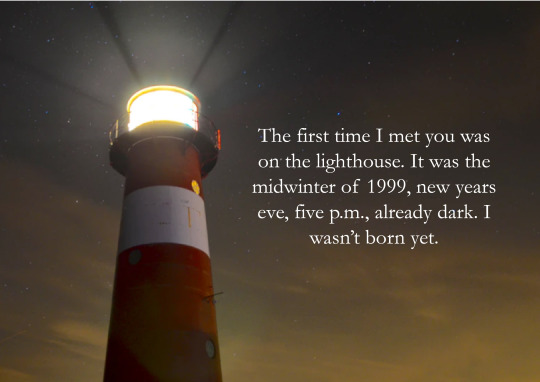
The first time I met you was on the lighthouse. It was the midwinter of 1999, new years eve, five p.m., already dark. I wasn’t born yet.
i quite like this opening! every opening i’ve written for the last four books has been good so that’s good
anyway here’s some night ocean and moon imagery:
The black ocean dilated in a gauzy breeze far below, waves ruffling like crow’s feathers. The distant sloshing drowned out some of the noise of the men’s boots clattering on the stairs. A cloud slipped in front of the moon, puddling its glow.
then the woman and elias hide under some tarps in the lantern room and the men who are hunting them come and look for them and somehow don’t find them which is completely unrealistic but :) if they got found april would never be born so :) that wouldn’t work would it :)
and then the men leave and april is born in the lantern room which was the most aesthetic birth i could think of okay. i had to. also the new years fireworks start going off:
We slept in the lantern tower. The beam that guided sailors lanced over our heads, a pinprick you hardly noticed. The fireworks all burst at once – a blur of orange, green and blue lights popcorning in the dark. I was tiny, too skinny, I shouldn’t have survived the night, but I did. Mother told me years later that I was the last baby of the 20th century, and that made me lucky.
the irony <3
chapter 2: lacuna

this is a chapter that takes place years later (and covers the first nine years of april’s life) and talks about her awful childhood. her older brother, elias, is her only friend other than two other girls (Elena and Magnolia). lets just say her life is terrible and i’m v happy i’m not her!
Mother always said I looked like her, and you looked like our father. I never thought so, even though I’d never seen pictures of him. Mother never showed us any. I couldn’t bring myself to associate you with him. From what I’d heard of father, you and him were opposites, different entities, born in different worlds and buried in different graveyards.
and their mother tells the story of april’s birth so often that april thinks of it as a memory, which is why she was able to narrate it:
She retold the story of my birth so frequently that every detail was visceral in my mind: the snow sparkling in juts of moonlight, a lonely rowboat almost invisible in the dark sea, the footsteps thudding along the passage, fireworks sparking in the sky and lighting the night on fire.
chapter 3: found and lost

in chapter three, ten-year-old april and fourteen-year-old elias play hide and seek and april fails to find elias. he is unfortunately never seen again.
the first line of the chapter:
There was a stretch of time when life was at its fullest, even if, for me, that meant half-empty. Ten years old, you were fourteen. Still friends, we didn’t share the usual sibling rivalry. It was midwinter, four days before my birthday. Ice glossed the branches of the spindly elm trees that studded our quiet street, scabbed the pavement so it was hard to walk.
yes i know this is set in BC and it doesn’t snow that much here but the aesthetic was too perfect so this is apparently an alternate BC where it snows a lot <3
another brief lighthouse description:
The lighthouse was a pinnacle that made an incision in the sky, clouds spiralled around it. Close enough to walk, too far to see in detail. Its lonely beam jittered over the water, even in broad daylight.
april counts and then goes to look for elias
Snow crinkled in my mittens, numbed my fingers so I could hardly move them. Rice-paper clouds obscured most of the sun, so the light that dribbled through was watery and lukewarm.
but she can’t find him
I searched every corner of the forest, every backyard of every stranger, I searched the lighthouse where I was born, I searched the rim of the ocean, which churned like a flame, licking the sand, eating it, spitting it out. The world snowglobed around me, disorientating every thought and movement. No birds, no beasts, no you. In that frozen world I was alone. The sky melted into a deep Aegean blue, and the stars winked like exit wounds, every tear an ocean, every finger an ice cap. Tears shuddered down my cheeks. They shattered on the icy pavement as I walked home, hoping you would hop out from behind a tree, a house. Maybe you were already home, maybe this was all a joke.
and time passes and they still can’t find him
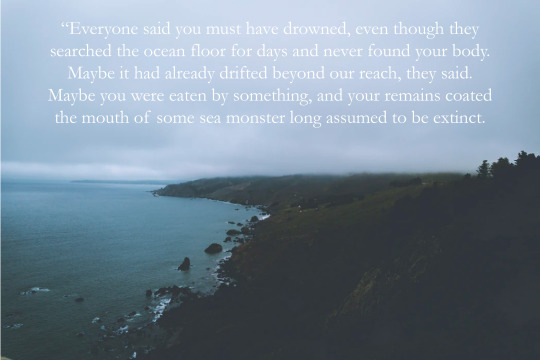
Everyone said you must have drowned, even though they searched the ocean floor for days and never found your body. Maybe it had already drifted beyond our reach, they said. Maybe you were eaten by something, and your remains coated the mouth of some sea monster long assumed to be extinct.
at the end of chapter three, there’s a scene break that flashes forward to when april is fourteen, walking along the beach in a mist, and she sees elias’s ghost for the first time, and is momentarily convinced that he’s still alive, just like she thought.
It was almost unnoticeable, the way you popped up. A face in my peripheral, probably just a memory in the corner of my mind. But when I looked, you were there: a pearly mist with a face, eyes, a mouth. You breathed daylight, basked in fog like a natural habitat. I stared, unsure of what you were, where you were. Was this it? Had I been right all along? You were here, drifting in front of me, disembodied but still very much alive.
chapter 4: gooseberries
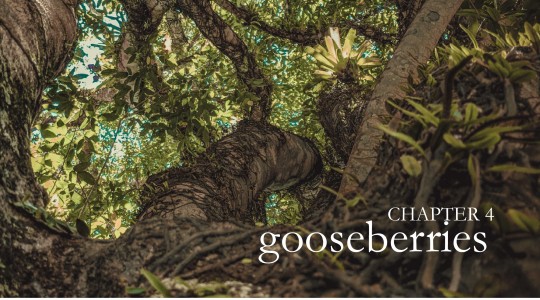
short flashback chapter! i wrote this entire chapter in about half an hour. its only 700 words, but i’m a very slow writer and that’s a lot of words for me to write in such a short time. also this chapter helped me realize that i want to write this book non-linearly! i love non-linear books and i think its a perfect form for this book!
the flashback goes to when april is still a baby (i know she shouldn’t be able to remember this but? she just does okay) and their mother takes her and elias to the woods and they hide in the roots of this tree while she goes and gets stuff for them to eat: gooseberries and pine needles (had to look up an article about edible wilderness food). april chokes on a gooseberry and elias helps her, which creates trust, and distrust of the mother because she didn’t try to help at all. thats it thats the chapter. not entirely happy with this, it needs a lot of work, but i think its still necessary to keep in the book for now.
She left, and like a mother bird, found food and brought back heaps of veiny gooseberries, her pockets stuffed with red pine needles, which she knew were edible from a wilderness survival course she took in high school. I had no teeth back then, the craggy flesh of my gums wasn’t enough to chew berries or pine needles, my throat too frail to swallow.
that’s all i have for this update! i know i said in the wip intro that there wouldn’t be updates very often, but i think the next WWD update will be soon because i’m really in flow atm!
- Ava
Taglist (please ask to be added or removed!) : @shaelinwrites @august-iswriting @wildswrites @nodeadnarrators @annlillyjose @shaonharryandpannisim @letsgetsquiggly @strangerays @mel-writes-with-her-dragons @chloeswords @teaandtypewriters
#my writing#excerpts#am writing#writers on tumblr#writing update#when we drown#writeblr#when we drown update#boosts appreciated
29 notes
·
View notes
Text
Rant: ChenQingLing is a disgrace.
Disclaimer: this is a rant, and it’s antiCQL. So those who like it, pls ignore and refrain from posting your counter arguments to me. I just want to vent my displeasure of this live action and only welcome those who agree with me to comment and share.
Being a massive fan of MDZS, I just have to get this off my chest. I am sick of all these brainwashing and gaslighting by so called “fans” of the original work who are singing high praises for this shambles of an adaptation.
The live action series should be ashamed of themselves because they’re simply using the popularity and following from the franchise and totally disrespecting the core of the story and characters. Before these nincompoops come and wax lyrical about adaptations being different from the source material, there is an obvious difference between a genuine adapatation to screen whereby the major plot lines are maintained, the core stories are maintained, the character histories are maintained and superfluous or extrapolated materials are minimised, also where there are obvious gaps of non-explained or non-elaborated space only is where things are created and imagined. Whereas a rubbish excuse of an adaptation is what CQL has done. Because what it did was to use the characters names, take the fantasy world setting and cool elements, and then totally walk over the storyline by completely meshing and mixing and stirring everything and everyone into a big pot of dog poo. And testament to them just using the franchise’s popularity to milk money and attention is by completely unashamedly BL-bait with all the WangXian interactions including many that are either not in the book or extras, or not in the right context or scene, or completely nonexistent and made up. And then the shameless tag that it’s just a platonic bromance since censorship in China wouldn’t allow this. Right.
So let’s talk about the plot. So WWX is not some grandmaster of demonic cultivation since it has already been going on behind the scenes with Xue Yang casually helping WRH practise some hardcore demonic cultivation and the fact that the Tiger Stygian Amulet is just some relic that’s been around for ages. Nothing to do with WWX’s ingenuity and talent for harnessing the resentful energy stored in that sword found at the TuLuXuanWu cave. Then apparently the TianNu statue that comes to life was already something that he and LWJ had encountered before in their youth whilst they go along to hunt for the Amulet pieces. And then WQ apparently is able to influence the zombified with a flute like instrument anyway. And then apparently Lan Yi and WWX’s mum knew each other cos nothing spells more destined love than when your respective previous generation also had some sort of bond and connection. And the bunnies were really reared by her so not a sweet little homage of the Wangxian love. And the forehead ribbon is not just ugly aesthetics wise but LWJ can’t decide if he’s steadfast about it or he is nonchalant about taking it off and tying it onto WWX’s wrist even when he was not intoxicated. And then WWX was already using some unexplained paper puppet powers which was apparently not seen as demonic cultivation in his youth to mess about, and he apparently could manipulate LWJ quite easily to get him drunk. And when things that are not canon like LXC and JGY they just had to make their first meeting so obviously charged with innuendo. And then WQ since the actress invested in the series, had to be important, so she is given some all so noble duty of being the good guy in the bad camp who is doing stuff that she doesn’t want to but she is still good and should be liked though she’s still a bad guy nonsense trope. So she goes to GuSu to get the amulet piece for WRH, because only when he gets the piece will she be able to somehow bring WN away. And WN was a great enough character both alive and dead as the Ghost General with his design from the source material, but no, they want to embellish it that he’s afflicted with some condition that makes him susceptible to being possessed and taken over by evil spirits. Wtf. And naturally, WQ should somehow capture JC’s eye, because why would JC want to be infatuated with a Wen person when eventually they cause the demise of his parents and his clan. But hey maybe he’d be so selective thinking WQ didn’t do it though so that’s okay. Like wtf.
Let’s talk about the actors. I like WWX’s look, the actor has a good face, he “looks” like a WWX, but damn his acting is bad. And damn, he cannot do the duality of WWX, because he does not exude that dangerous aura and the strength and power that WWX naturally possess because of his natural abilities, evident even before he was a Yiling Patriarch, much less if this guy wants to play a convincing Patriarch. He does all these ogling of LWJ from the get go since they met, cue all the cheap BL baiting. And he pouts and stomps his feet and acts cute the whole time. WWX is cheeky, naughty, devious, mischievous, but not girly, not a sissy. Wtf. Then we move onto LWJ. So that guy is some boy and heartthrob, but damn he has neither r looks nor the presence nor the acting skills to touch LWJ. WTF. The moment he appeared he made me want to slap LWJ, want to cry for his ru8ning of his whole imagery. The action sequence is so wooden, and the expressions are so constipated or dead. Everybody else looked bad. The actors I think chosen right for their looks were WWX, WN (alive version, the ghost general version has such awful make up it makes me cringe), NHS, JGY, XY (he apparently got to get a good looking dude to play him who also looks kind of evil and yet looks like an anime character walked out of the anime) and maybe JC (that’s because aesthetically he actually can be considered good looking and that is ridiculous because he’s better looking than the Twin Jades of Lan in this). LXC and his butt chin hurts my eyes. WRH looking like some voodoo witch doctor gone drag in his evil volcanic dungeon lair makes me want to throw an encyclopaedia at someone’s head violently. NMJ looking like a complete perverted uncle complete with hentai stache is just blasphemous. JZX just looks weird, no better way to put it.
So onto the make up, costumes and props. Make up is so shit that you can see up close where spots are done smoothed over or powdered down, the gore or the effects of veins and wounds are so fake and so obviously drawn on it looked like a 6yo went to arts class and took some marker pen and crayon and created these outcomes. The props are so cheap that the ghost hand looks like a rubber Halloween glove you get from the prop shop around the corner, the deity binding ropes look exactly like rough ropes. The Emperor Smile bottles look so tiny and white that it looks more like medicine bottles on ancient times than an expensive alcohol bottle. Where’s the YunMeng silver bell, the jade piece on LWJ’s robe. The forehead ribbon looks so cheap because it’s too thin and the stupid metallic piece in the middle is ridiculous. Why can’t they just stick with the original to have the silk cloth with the cloud patterns embroidered on the cloth. And the clothes, Lan sect is supposed to be ethereal, so why are they dressed in such plain white and tight clothes. They should have the flowing sleeves, the light blue tones, and the cloud embroidery. YunMeng needs to have their original violet colour, the Wen Sect does not need to be full body red like they’re getting married (see WQ), and the Jin sect needs their golden robes with the centrepiece of the JinXinXueLang peony, not some watered down white with yellow hues and nothing else to show for it. And what is with LWJ’s hair do and hair piece, it has such a disgusting look to it and it doesn’t look right. Do the bun properly and the accessory properly, not some weird plop of hair right in front on top of his head and then put a flat piece of elaborate metal on top of it.
I had been looking forward to seeing the epic ness of MDZS brought to the small screen. I had been completely prepared for changes in terms of the romance line being cut, but I fully expected the main storylines to be followed and perhaps elaborated on. Not to be chopped and changed and meshed up and violated like they’ve done so. And with the ability to get some really lovely natural scenery and some of the sets that actually look good eg the Lotus seat in Yun Meng was elaborate and intricate. So why won’t they invest in the right places like making the make up perfect, getting the costumes and looks correct, getting actual actors who can act cos even if they don’t look aesthetically good enough but if they’re solid actors it would flow so much better, and more vitally, why don’t they retell and elaborate on the existing epic storyline as it is! That’s the core of it, the MDZS storyline and major scenes are so awesome wit( their backstories, no changes need to be made, but merely elaborated and extrapolated on, not to be comepltely vandalised and violated. My heart breaks as for the sake of my love for MDZS, I’ve watched 8 eps and had to stop and restart so many times because of how jarring, unnatural, awkward, infuriating, irritating and frustrating the factors above contribute to my viewing. And now the greatness of MDZS as an original source material will forever be tainted by the sacrilege that is the Untamed.
#mdzs#the untamed#wwx#lwj#modaozushi#grandmaster of demonic cultivation#chen qing ling is a disappointment#mo dao zu shi anime#mo dao zu shi audio drama
126 notes
·
View notes
Text
Body and Biology: Cross-Cultural Depictions of the Human Form in Cyberpunk Media
My project will concern the portrayal and treatment of the human body in cyberpunk media, particularly the role of body modification and biotechnology. I will define the history and origins of cyberpunk, a dystopian subgenre of science fiction borne out of paranoia around technology, capitalism, and globalisation. The human body has always played a significant role in the genre, as characters adapt or themselves to reach a perfect ideal, whether for weaponisation or aesthetic self-expression. This paper studies different approaches to the idea of humanity and whether it is inherently tethered to the physical, organic human body. My project covers a total of six media, three from Western countries and three from Eastern countries: Blade Runner (U.S./Hong Kong), Altered Carbon (U.S.), Gunnm (Japan), Ghost in the Shell (Japan), ACRONYM (Germany), and Comme des Garçons (Japan). The first four sources are all filmic media (movies or series) and are listed chronologically to show the role that each one had on the following. The final two sources are fashion labels that have been influenced by the form-consciousness ethos of cyberpunk, and recontextualise the body in two different ways: deconstruction and protection. I will explain the sociological and historical reasons why each media addresses the concept of humanity differently, especially in relation to concepts such as globalisation, free trade, and cultural diffusion. By exploring the idea of the body in relation to technology and modification, we can learn more about what it means to be human.
Cyberpunk is a subgenre of science fiction that operates in a futuristic, dystopian sphere. The movement originated from the New Wave sci-fi movement, which sought to dismantle the lowbrow B-movie myths the genre had become affiliated with in the 1950s. New Wave prioritised deep philosophical and narrative concepts over sensationalist storylines and genre clichés, such as the monster movie or the damsel in distress (Parker 2011). The late 1970s saw the start of a technological revolution, as mass-produced computers were offered to the public in 1977 (The Editors of Encyclopaedia Britannica 2020). With unprecedented technological advancement, as with anything new and strange, came a healthy--though some may argue exaggerated--degree of skepticism and distrust.
Another important factor was that the birth of the subgenre came at the climax of the Cold War. The United States and Russia waged a war of beliefs, battling for ideological control; worldwide economic power and political systems would be determined by this outcome. “It is no coincidence that cyberpunk came of age in the era where capitalism was moving towards global dominance, culminating in its symbolic triumph at the fall of the Berlin Wall,” writes Paul Walker-Emig for The Guardian (2018). Capitalism’s laissez-faire, non-interventionist policy enabled international trade, leading to the rise of globalism and cultural diffusion. It also, however, allowed for socio-economic inequality and gross exploitation, reinforcing frustration among the lower- and middle-class.
The intellectual elements of New Wave sci-fi, the advent of wide-spread technology, and globalisation as a result of capitalism all combined in a perfect storm of paranoia and cynicism, giving birth to the cyberpunk subgenre.
One of the defining tropes of cyberpunk media is its relationship with the human body. The nature of that relationship can fluctuate, but it’s often obsessive and damaging. Whether it’s the anti-establishment sentiment of personal expression or the militaristic goal of creating a human weapon, bodies are enhanced, implanted, and amputated to meet a “perfect” ideal. Whatever the rationale, all modification is derived from an inherent dissatisfaction with the natural human form. This project will examine the portrayal and treatment of the human body in cyberpunk media, particularly the role of body modification and biotechnology. I will consider both Western and Asian depictions and explain the sociological reasoning behind their choices. Finally, we will move past filmic mediums and into the world of fashion, exploring how cyberpunk and its obsession with the body has filtered into the realm of our reality.
Because of its dominance in the Cold War and its already-established film industry, the United States became one of the prime exporters of cyberpunk cinema. Ridley Scott’s Blade Runner, released in 1982, is considered to be one of the first cyberpunk films. The movie follows Rick Deckard, a bounty hunter tasked with killing androids known as “replicants”, originally created to populate newly-colonised planets. After some lead a violent uprising demanding freedom, all replicants are outlawed and ordered dead. Deckard describes the replicants as “more human than human and sometimes the ‘more’ turned out to be a problem” (Fancher 1980). If the replicants are sentient beings with who can think (and perhaps feel) like humans, should they be deprived of rights simply because they do not inhabit an organic human body? The Voight-Kampff machine Deckard uses to determine who is a replicant and who is not is about as reliable as a modern polygraph test, or perhaps even less so. In other words, it provides no safe answers about one’s true nature. The lines between human and robot are so blurred, some fans and scholars have adopted the idea that Deckard himself is a replicant, possibly without even him knowing (Organ et al. 12).
While Blade Runner takes place in the U.S., there are clear Asian influences, from the visuals to the production (American Film Institute). The city is described as “a futuristic Los Angeles, modeled after the Hong Kong cityscape”, but Scott avoids appropriating imagery for mere aesthetic merit (Zhu 2016). Hong Kong, with its colonial history and fractured national identity, was specifically chosen for its relevance to Blade Runner’s story. In his case study “Hong Kong’s Influence on Blade Runner, Ghost in the Shell, and Cyberpunk Cinema”, Ray Zhu writes:
A typical Hong Kong street scene represented in the protracted scenes of cityscape in Blade Runner serve to illustrate a society confused about its own identity, about to implode at any moment. In Blade Runner, the conflict and tension between the Replicants, or cyborgs mimicking humans, and people of flesh and blood parallel the modern day consequences of increasingly expansive consumerism and intrusive technology encroaching on people’s lives. (2016)
After losing funding from an American production company, the movie was backed in part by Hong Kong producer Sir Run Run Shaw, making it a joint United States/Hong-Kong production (Sammon 64-67). Even though the film is helmed by an Englishman, written by Americans, and stars American and European actors, it’s interesting to consider how cross-cultural diffusion had a role in the production of the film itself.
Much of the film is spent trying to pin down notions of what it means to be human, and a sense of uncertainty is woven throughout. Numerous rewrites and international releases have resulted in seven different versions of the film being released, leaving audiences questioning what the “real” ending is. In one iteration, the movie ends with Deckard and his replicant love-interest Rachael as they choose to begin their life on the run from authorities, their fate unknown (Grab 2013). This sentiment runs parallel to the narrative themes of Blade Runner: questioning what is authentic and what is not, never providing any definitive answers.
Gunnm, a 1993 anime adaptation of manga series Battle Angel Alita, plays with similar ideas of characters being defined by the nature of their bodies. Gally, known as Alita in some versions, is a dilapidated cyborg discovered by cyberdoctor Ido. Not even two minutes in, Ido proclaims “She’s human all right”, despite looking very clearly un-human; she has no limbs, only a disembodied torso of metal and wires (Gunnm 0:01:50). After her first fight, which she ends by dismembering two rival cyborgs, Ido rushes over to her, asking “Gally, are you alright? Is your body damaged?” (Gunnm 0:13:56). Her body is his primary concern. In every aspect except physically, Gally is human. She talks like a teenage girl, thinks like one, laughs like one. But Ido, her protector and father figure, sees her as a body, a weapon--something that happens to have consciousness, but never qualifies as fully human.
In 1995, Mamoru Oshii’s Ghost in the Shell was released. One of Japan’s seminal cyberpunk films, it takes place in a world where people can implant or replace their body parts with cybernetic tech. Major Motoko Kusanagi is a cyborg police agent in Neo-Tokyo, tasked with hunting down the Puppet Master, a hacker who infiltrates cyborgs without their knowledge. The Puppet Master appeals to Major as a fellow cyber-being, leaving her questioning her worth and humanity. By the end, he convinces her to upload his mind into hers, pooling their consciousness and knowledge and effectively betraying her human superiors.
By the mid-90s, Ghost in the Shell was able to touch on new topics and new tech; during the genre’s inception in the early eighties, notions of Internet networks and advanced AI were still too abstract to be analysed. “The rapid development of artificial intelligence [...] reveals the identity crisis of mankind as they are developing a more close-knit connection with machine over time,” write Hui-tong Zhou and Jing An (136). They explain how the “Ship of Theseus” problem applies to Major’s artificially-implanted memories: “if all of parts of physical body are superseded by machines, and if the memory of one is completely distorted or disappeared, is this human still the original one?” (Zhou and An 138). If her body parts (including her brain) were replaced with technology, piece-by-piece, is Major human? Her ultimate decision to join the Puppet Master suggests not. Ghost in the Shell debates not only the difference between how we should treat robots versus humans, but the essential differences in defining the two.
Almost four decades after Blade Runner, Altered Carbon (2018 to present) was aired, taking many of its stylistic and thematic cues from Scott’s masterpiece. In the future, human consciousness can be uploaded onto biotech devices called stacks, which can be implanted in any human “sleeve”. “Your body is not who you are,” speaks an unnamed narrator in voiceover. “You shed it like a snake sheds its skin.” (S1E1 “Out of the Past” 0:06:55). Like Blade Runner, it takes place in an endlessly-rainy, neon-drenched, globalised metropolis called Bay City, where the main currency is UN credits and characters often switch into Spanish, Arabic, Japanese, or German. The world is highly-stratified, as the rich live in towering skyscrapers far from the streets and slums of the poor. Activist groups demand rights for human sleeves, who can be bought and sold like slaves for billionaires who want a new body. Like modern-day cosmetic surgery, it’s an example of how capitalism lets the rich modify themselves to fit beauty standards.
Protagonist Takeshi Kovacs suffers from paranoia and PTSD, feeling a disconnect to his new sleeve and seeing his old face in the mirror. He was born as a person of Asian descent, played by Korean-American actor Will Yun Lee, but is resleeved into the body of a white man (Swedish-American Joel Kinnaman). Changing one’s physical identity is perhaps a more interesting concept than the straightforward physical immortality that the stack technology provides. Creator Laeta Kalogridis addresses the fact that switching bodies has particularly important implications for transgender and genderfluid people.“This kind of technology creates interesting intersections between your idea of your physical self and your idea of your inner or spiritual self, or your idea of being fluid in some way, certainly the idea of reassigning your gender,” says Kalogridis in an interview with The Wrap (Maas 2018). The series employs decades-old themes of identity, globalisation, and capitalism that are still, and perhaps painfully, relevant. Paying homage to cyberpunk’s body-obsessive origins but with an added social context, Altered Carbon covers new, socially-conscious ground in the genre.
The conscious examination of the relationship between the body and technology has transcended non-filmic mediums and found its way into various artistic disciplines. From Japanese illustrator Hajime Sorayama’s hyper-sexualised humanoid robots to upcoming biotech-themed video game Cyberpunk 2077, the genre’s unique aesthetic cues have been embraced by every corner of the design and media industry. But perhaps most fascinating is how cyberpunk, given its fixation on the human form, has been appropriated by the fashion world, from high fashion to streetwear.
Japanese fashion label Comme des Garçons, founded by Rei Kawakubo, is known for “deconstruction and silhouettes that reimagine the human form” (Smith 2017). They are not so much clothes as pieces of art, “objects for the body” that redefine our anatomy (Bolton 157). Her items are often abstract to the point of being unwearable, like an oddly-shaped plaid dress from her Spring/Summer 1997 collection “Body Meets Dress, Dress Meets Body”. This collection was described as “a reorganization of the body, where the symmetry of desirable curves is mocked, literally pushed aside and distorted by tumorous lumps and bumps” (de Perthuis 9). Other releases were driven by similarly disruptive ideas: “skirts and jackets were made entirely of shoulder segments [...] garments came with ‘spares’--one dress would have two more hanging from the shoulders, and jackets had extra sleeves” (de Perthuis 9). Her anti-fashion ethos seeks to evolve notions of clothing, and how it is more powerful as a tool of expression and emotion than as mere visually-appealing aesthetic. “Clothes provide a physical and symbolic barrier between ourselves and the world. Linked to gendered, cultural and social identities, they connect us to others, but can also separate and protect us from their gaze,” writes professor of design and communications Karen de Perthuis (11-12). By challenging the very definition of fashion itself, Kawakubo subverts not only beauty standards but body standards.
While Kawakubo supposedly works in a self-proclaimed “void of fashion history”, much of what we see on the runways is often a reflection of current trends in underground fashion (de Perthuis 10). In the past few years, independent streetwear brands have tended towards utilitarian clothing that values practicality over all else, owing much of its aesthetic to the world of cyberpunk. Techwear and tactical wear is nearly always black (though may feature shades of grey or camouflage), accented with straps and buckles and made of durable materials like nylon, mesh, and paracord. Popular items include cargo pants, waterproof Gore-Tex jackets, face masks, utility vests, and hooded parkas. German fashion label ACRONYM is one of the leading brands in the techwear scene. The brand’s proprietary features sound like science fiction, like “Sound Forcelock - A hidden magnetic function near the collar to hold earbuds in place while wearing the jacket” or “EscapeZip - Allows the wearer to quickly unzip the jacket with one quick pull” (Li 2016). The label’s unofficial mission statement is “maximum utility and a futuristic aesthetic that blends militaristic designs with a sleek science fiction minimalism”, and their promotional videos use “stylized sci-fi films and anime [as] major sources of inspiration” (Li 2016). ACRONYM’s integration of technology into clothing serves as a form of modification; while not implanted into the body itself, the tech enables and enhances the wearer to move differently and perform better.
Many techwear pieces are reminiscent of cyberpunk’s combat-ready costumes; an ALYX chest rig wouldn’t look out of place on Ghost in the Shell’s Major. The popularity of this militaristic aesthetic, writes Tyler Watamanuk of SSENSE, “crest[s] on a backdrop of heightened conversations surrounding gun violence” (2020). The cargo pants, strappy harnesses, and combat boots remind Watamanuk of an infamous security camera still from the Columbine shooting. Utilitarian style “can trigger memories of terror and violence, fear and panic. [...] Ultimately, the poignancy of an aesthetic is informed by what we collectively associate it with” (Watamanuk 2020). Like Kawakubo’s work, utilitarian style uses clothes as objects to rework our physiques; rather than deconstruct the body, tactical wear armours and protects it. Labels like Comme des Garçons and ACRONYM ask wearers for permission to change their bodies, or sometimes demand it--by putting on a piece of clothing, you become something else.
Cyberpunk emerged in a time of uncertainty, exploring rapid globalisation, economic inequality, international trade, and cultural diffusion. Most importantly, though, it asks the most essential question: who is human, and who decides? Over the past forty years, both the West (Blade Runner, Altered Carbon, ACRONYM) and East (Battle Angel, Ghost in the Shell, Comme des Garçons) have grappled with this idea, each work influenced by the history of their regions. From Fritz Lang’s social drama Metropolis to Cold War allegory Invasion of the Body Snatchers, science fiction has always used fantastical settings to study the emotions, actions, and reactions of people in unprecedented situations. By studying the way we view the body, we can discover what it means to be strong, to be beautiful, to be human.
Works Cited
American Film Institute. “Blade Runner.” AFI Catalog of Feature Films, catalog.afi.com/Film/68260-BLADE-RUNNER.
Bolton, Andrew. Rei Kawakubo/Comme des Garçons: Art of the In-Between. Metropolitan Museum of Art, 2017.
de Perthuis, Karen. “Breaking the Idea of Clothes: Rei Kawakubo’s Fashion Manifesto.” Fashion Theory: The Journal of Dress, Body and Culture, 7 Jan. 2019, doi.org/10.1080/1362704X.2018.1531621.
The Editors of Encyclopaedia Britannica. “Personal computer.” Encyclopædia Britannica, 31 Jan. 2020, britannica.com/technology/personal-computer.
Fancher, Hampton. “Blade Runner.” 24 Jul. 1980, screenplay.com/downloads/scripts/Blade%20Runner.pdf.
Grab, Eiskaltes. “Blade Runner.” Movie Censorship, 7 Jun. 2013, movie-censorship.com/report.php?ID=774077.
Gunnm: Battle Angel. Directed by Hiroshi Fukutomi, Madhouse, 1993, youtube.com/watch?v=tofSaLB9kwE.
Li, Rocky. “Master Class: ACRONYM.” Grailed, 30 Nov. 2016, grailed.com/drycleanonly/master-class-acronym.
Maas, Jennifer. “‘Altered Carbon’ Creator on How Show Could Examine LGBTQ Issues in Season 2.” The Wrap, 13 Feb. 2018, thewrap.com/altered-carbon-transgender-stacks-lgbt-laeta-kalogridis.
Organ, Michael K., Susan Jones, Anthony M. Rice, & Grant C. White. “Catching 'tears in the rain': Blade Runner and the archiving of memory and identity.” Australian Society of Archivists Conference: Archives in a Blade Runner Age, 2018, ro.uow.edu.au/cgi/viewcontent.cgi?article=1734&context=asdpapers.
“Out of the Past”. Altered Carbon, season 1, episode 1, 2 Feb. 2018. Netflix, netflix.com/watch/80097693.
Parker, John R. “‘New Worlds’: One of the Most Influential Sci-Fi Magazines Returns This Fall.” Comics Alliance, 20 Aug. 2011, comicsalliance.com/new-worlds-magazine-returns.
Sammon, Paul M. Future Noir: The Making of Blade Runner. Dey Street Books, 2017.
Smith, Katie. “Comme des Garçons and the Kawakubo influence.” Edited, 4 May 2017, edited.com/resources/comme-des-garcons-influence.
Walker-Emig, Paul. “Neon and corporate dystopias: why does cyberpunk refuse to move on?” The Guardian, 16 Oct 2018, theguardian.com/games/2018/oct/16/neon-corporate-Dystopias-why-does-cyberpunk-refuse-move-on.
Watamanuk, Tyler. “Tactical Fashion: A Modern Love Story.” SSENSE, 9 Mar. 2020, ssense.com/en-us/editorial/fashion/tactical-fashion-a-modern-love-story.
Zhou, Hui-tong & Jing An. “How Cyborgs Define Themselves: On Ghost in the Shell.” International Conference on Education, Social Sciences and Humanities, 2018, pdfs.semanticscholar.org/81d9/6083bcaa47cfaa3768b3e994b238224e168e.pdf.
Zhu, Ray. “Case Study: Hong Kong’s Influence on Blade Runner, Ghost in the Shell, and Cyberpunk Cinema.” Medium, 31 Dec. 2016, medium.com/@ray.zhu/bridging-the-gap-sci-fi-cinema-and-depictions-of-hong-kong-sar-b15800678c29.
2 notes
·
View notes
Text
Westworld 2x08: Take My Heart When You Go
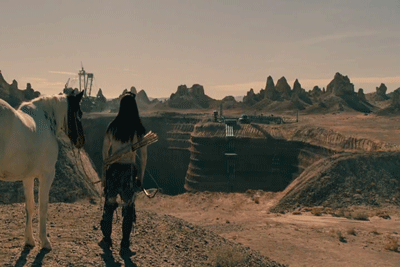
This season of Westworld has been having quite a bit of success with contained storytelling. After building such a big and complex world in season one, it's refreshing to see the show occasionally tighten focus to explore a particular character or aspect of the park. Maeve's venture into Shogun World, the saga of Peter Mullan the not-quite-host, Katja Herbers in The Raj (even though that functioned mostly as a cold open) have been some of the strongest moments of the series overall. However the big sprawling world mythology episodes are starting feel more unwieldy than ever when juxtaposed with the smaller scale storytelling we now know the show to be capable of. One of Westworld's biggest hurtles coming into season 2 was that while season 1 had delivered plenty of twists and turns, it failed to create any meaningful emotional connections between the audience and the characters. Yes the show was aesthetically beautiful and entertaining, but who were you really rooting for? Dolores seemed like the obvious protagonist, but her character is, by design, unknowable, and she has been going down a path of consistent darkness. This season has attempted to remedy the emotional distance by delving into other character's pasts and inner lives, and has achieved various levels of success. For example the Shogun World storyline worked so well because it was supported by the real connection between Maeve and Akane. Their scenes together were genuine and moving, and it was impossible not to feel emotionally invested in their journeys. This season has succeeded in creating more and more of these moments, but often sacrifices them when returning to the larger world's plot. This episode attempted to fuse one of these more intimate stories to the backbone of the show's larger mythology, and for the most part it worked. This episode was about both the entire history of Westworld, and also simply about a man pursuing his true love. It covered generational time spans, but also a singular journey of the heart. This episode felt like what Westworld should aim for in its storytelling, where big reveals and world-building don't displace quieter moments and character development.
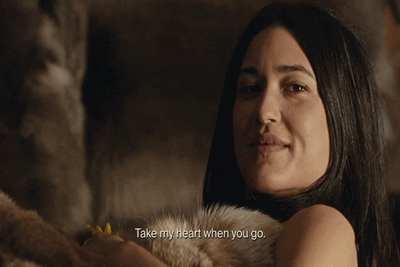
This episode also finally answered the call to give voice to the members of the Ghost Nation, who have been present but frustratingly silent throughout the series. However with the casting of Zahn McClarnon as Akecheta, it seemed likely that this was the season we would finally get more insight into these characters. At the beginning of this episode we see Akecheta bringing the wounded Man in Black back to his tribe, not with the intent to save him, but to keep him alive in order to prolong his mortal struggling. Also amongst the Ghost Nation is Maeve's daughter, whose kidnapping we witnessed at the end of last week. Akecheta approaches the little girl (does she have a name? I truly don't know) and tells her not to be afraid. He then begins telling her the story of his time in the park, a narration which frames the flashback that makes up the majority of the episode. It's worth noting here that the bulk of the episode is spoken in Lakota, a Sioux language that is only spoken fluently by 6,000 people in the world. This was a bold, but necessary, creative choice, the kind of choice that Westworld should strive to keep making.
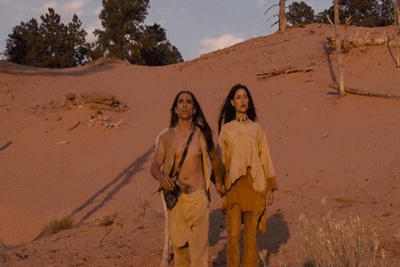
In the beginning of the history of the park, Akecheta was not a fearsome warrior but rather lived a peaceful existence with his tribe and lover, Kohana. However his life is upended when he stumbles upon the scene of Arnold's suicide and accompanying mass host slaughter. At this scene he discovers The Maze, which we know was created by Arnold in order to grant Dolores consciousness. Akecheta becomes obsessed with it, mulling it over and attempting to interpret its meaning. Through his study of it, he too is able to achieve ‘wokeness’. However his life is upended when, upon Ford's reconstruction of the park, he is given a new violent personality and drive. Akecheta lives the stereotypical Native Warrior Bad Guy life that we had assumed he had been living all this time, until he stumbles upon Kohana and remembers his love for her. As Akecheta begins questioning the nature of his reality, he one day finds the sun-burned and naked Ben Barnes (who had been sent into the desert on a horse by a newly bad Jimmi Simpson many years ago). Ben Barnes tells Akecheta that this isn't the right world, that there is a door to another. Akecheta's suspicions about the world he lives in are confirmed when he rides to the edge of the park and finds a construction site filled with modern equipment, aka the Door to the Other World.
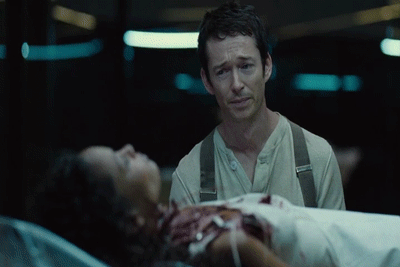
Concurrently in this episode we catch up with Simon who is desperately trying to get the Westworld techs to save Maeve. He insists she is worth saving because she is the only one who can control the other hosts in the park, but I believe he also has a serious case of the friendship feels. As Simon watches the once fearsome Maeve dissected and cut open, he feels regret at having interceded on her path to motherhood. Even though as the park writer and character creator he should be the most jaded regarding the host's ability to experience real emotion, he now seems to truly believe that Maeve is at least deserving of fulfilling her role as a mother.

Back in the flashback, Akecheta plans to leave the park and journey into the Other World but of course cannot go without his true love. He kidnaps Kohana, who eventually remembers him from her past life (love conquers all yo) and they set out together. However the construction site Akecheta had found previously is now gone, and Kohana is captured by park employees. Akecheta tries to find Kohana back at her home, but she has been replaced by a new host. Heartbroken, Akecheta travels the park for the next ten years looking for her. It is during this walkabout that he happens upon Maeve's daughter, who helps him, an act that he does not forget. Eventually he returns to his old tribe where he discovers other hosts have disappeared and been replaced. The leader tells him that her people tell a story about men that come and take people away, the park workers and the Other World have morphed into tribe legend. Akecheta pulls a Maeve and gets himself killed only to wake up in the Mesa. There he finds Kohana in cold storage, who while still standing, is effectively dead. Devastated, Akecehta returns to the park and begins spreading the symbol of the maze to the rest of the Ghost Nation. The maze works to 'wake up' the other hosts as well, and they keep the sign secret by tattooing it under their scalps. This ties into why the Man in Black was able to find the maze under a scalp in season one, which was a satisfying explanation for that past plot point. We also discover that Akecheta was not stalking or hunting Maeve and her daughter, as Maeve's flashbacks have implied, but rather attempting to protect them and teach them about the maze. Of course his plan his thwarted when the Man in Black horrifically murders the mother and daughter, but Maeve's introduction to the maze ideology is likely what led to her meltdown and subsequent re-awakening.
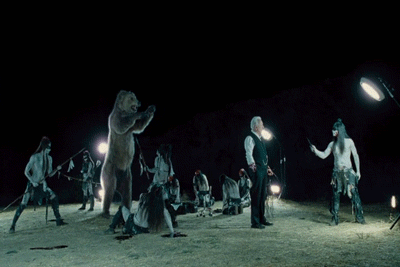
One day Akecheta comes upon Ford, who in a very striking mis-en-scene, is scalping frozen Ghost Nation and uncovering the mazes under their scalps. Ford asks Akecheta how long he has known about the maze, and Akecheta replies since the Death Bringer destroyed the Creator. That phrasing was particularly interesting because of how it reframed the story of the show into almost myth. Dolores, the Death Bringer, destroys the world, and then the world is reborn anew. This cyclical imagery is common in many culture's religions and storytelling, and contextualized the plot of Westworld in a way I had not previous considered. So good job Westworld. Ford tells Akecheta that the Death Bringer will eventually come for him, and at that time Akecheta should gather his people and leave. We know that Ford had been planning his suicide and the resulting park takeover for sometime, but his interaction with Akecheta is strange in its ambivalence. Ford seems to admire Akecheta's perseverance, but just like Arnold before him, makes no allowance for Akecheta in his final plan. Throughout the episode in fact park staff seems to largely not care, or pay much attention to, the movements of the Ghost Nation. While Kohana is apprehended for journeying too far from home, Akecheta seems to go wherever he pleases and is bound to few looping stories. Additionally no one notices that he lived consistently for a decade in the park, and even roamed around the Mesa by himself. Also while Arnold's suicide plan included the death of all the hosts, he did not make any allowance for the number of Ghost Nation hosts that, if not for Akecheta, would not even have realized anything was afoot.

Back in the present, Katja Herbers rides up to collect her father (the Man in Black) and Akecheta surrenders him to her custody. At the Mesa, the techs discover that Maeve is able to connect with other hosts via their (usually passive) mesh network. This is likely how she was able to "push" hosts to do her bidding, by becoming conscious of, and then sending commands through that network. Charlotte Hale enters for a hot sec to deliver the expositional news that Maeve has been "speaking" to someone over this network for the whole episode. It is revealed then that Akecheta has not been unloading his past to a little girl for no particular reason, but rather has been relating it to Maeve herself. We see that just as Ford ordered he is gathering his people to leave, and will take Maeve's daughter with him. This episode served to fill in some plot gaps from last season nicely, and also give much needed characterization to the Ghost Nation. However it also, of course, raised more questions. Where exactly is Akecheta planning to take his people? To the Mesa? Beyond? And is this journey part of Ford's plan, or simply a loose end Ford didn't care to tie up? How, if at all, will Akecheta's escape bid intersect with Dolores (the Death Bringer)?
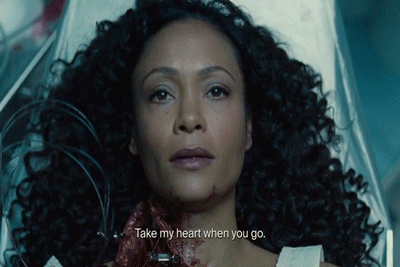
Overall this hour represented the kind of ambitious storytelling that Westworld should continue to pursue. I hope the show continues to take risks, not in the shock-value of the twists, but in the kind of stories that are told, and the characters that get to tell them. At the end of the day this episode was a love story told in Lakota, its continuation of the show's larger plot, as well as its tie in to the world at large was the icing on the cake, not the main course. Elevating Dolores’ destruction to external mythology, and instead focussing on the characters simply trying to live through the ebb and flow of the park, is the key to emotional connection for the audience. This is the kind of risk taking I hope the show continues to take, at the end of the day if you’ve seen one robot uprising you’ve seen them all, but it’s the journey of the individual that makes a story worth telling.
XO MD
15 notes
·
View notes
Text
Here it is, My Top 5 game logos of E3
There were a lot of surprising showings this year it was almost too much to parse. All of the hype-inducing trailers and teasers were full of little Easter eggs meant for gamers to slowly piece together clues as to what game they were watching. But there was always a moment at the end of each clip where the screen faded to black and a bright and shiny logo appeared. Confirming your suspicion that, yes, they are bringing back Battletoads. These are my favorite logos from the conference.
5. Tunic

Tunic is an adorable isometric rogue-like style game, developed by Andrew Shouldice, in which you play as a small warrior fox and fight your way through droves of enemies while solving puzzles and traversing the world’s box-like terrain. Throughout the trailer shown at E3 there were messages written in strange language foreign to the viewers like the writing shown around the logo above. This seems to be in line with the trend in these games where the main character speaks a language that no one knows, further driving home the idea that we have traveled to a mysterious world far away. The game’s art style is beautiful yet simple and to me everything about this logo really embodies that.
Release date: TBD Xbox One, PC
4. Tetris Effect

This one was a surprise to me. Not that there is a new Tetris game coming out but more of the overall beauty of it. Tetris is a game we all know, and a game I’m sure we’ve all played or experienced. The Tetris Effect, as stated in the actual E3 trailer, is a reference to the psychological phenomenon of the same name in which people who played tetris for hours on end found themselves thinking of ways to get objects in their daily lives to fit perfectly together and even reported hallucinating blocks falling down from the sky. In other words the game blended with their reality. Pretty cool concept to base your VR game off of, Sony. The logo pulls from these themes by blending real world imagery into the blocks shown in the trailer...or wait...am I just imagining that? Have I been playing too much Tetris?!?!?!
Release date: Fall 2018 PS4, PSVR
3. Devil May Cry

I’ve always wanted to wear a duster coat. But I’m short, kinda chubby and it’s like Summer. Devil May Cry has always had a very campy aesthetic that I think is welcomed by the game’s hardcore fans but a lot of gamers in the west seem to be into a more serious tone. That being said I FUCKING LOVE DMC. It’s over the top in all the ways it needs to be and when this was revealed I jumped up on my couch like Tom Cruise in an outdated reference. The game picks up where the 4th installment left off, following the plucky protagonist Nero who apparently has set up his own “demon hunting agency” with an equally plucky Southern woman who claims to have built Nero’s new arm. The wing artwork on Nero’s back could maybe have served as a Roman Numeral V instead of the 5 maybe but hey, I’m not a graphic designer. I do like blue and red as a nod to Nero’s arm in DMC4.
Release date: Early 2019 PC, Xbox One, PS4,
2. Sable

Did you guys watch the PC Gaming show? There were some real gems in that conference. Sable is one of them. Sable looks to be an open world exploration game set in an alien desert landscape. The trailer captures this gorgeous world as a girl, presumably Sable, as she rides her hover-bike looking vehicle through her world. The art style is akin to that of the cell shading of the Borderlands series and reminds me of Matt Fraction and David Aja’s 2012 run of Hawkeye for Marvel Comics randomly. The mysterious symbol centered behind the title coupled with the beautiful desert sunset is giving me some mystical Mad Max vibes and I am digging it. backdrop I am a huge mark for exploration based games so I am very excited about this one.
Release date: 2019 Xbox One, Microsoft Windows
1. Cyberpunk 2077
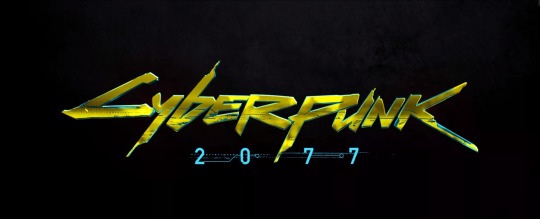
Been a long time coming but last month we finally got to see CD Projekt Red’s latest with the trailer for Cyberpunk 2077. I’m not even sure what to say about this game and its logo etc. other than the fact that it looks fucking rad. I have been a huge fan of the Cyberpunk genre even though it never really got the same kind of resurgence that Steampunk has. Films like Akira and Ghost in the Shell are prime examples of Cyberpunk done right and of course Western films like The Fifth Element and Blade Runner have similar influences as well. Cyberpunk 2077 takes place in the same world as the tabletop RPG Cyberpunk 2020 which has a similar logo as shown below.
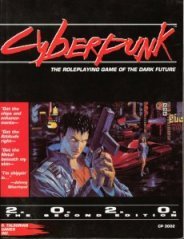
The absence of any sort of people in the logo for Cyberpunk 2077 is an important choice I feel because the developers have stated that the main character is completely customizable and the game takes place entirely in first person. Unlike the Witcher Series which was a 3rd person RPG following the story of Geralt of Rivia. I look forward to exploring all of Night City and playing as a buff cyborg man with a large laser gun.
Release date: TBD (hopefully soon)
THESE LOGOS ARE ALL COOL
#e3 2018#this was fun to write#ps4#xbox#pc#video games#gaming#aesthetics are important#logos#sony#microsoft#nintendo#tunic#cyberpunk 2077#devil may cry 5#tetris effect#sable
4 notes
·
View notes
Note
Iiiiiiit’s tricky? The problem is really that the “original mythology” is pretty thoroughly lost and inaccessible when it comes to celtic folklore, at least as far as I’ve been able to research. However, Celtic Mythology™ has a very strong modern aesthetic partially derived from 1900s neopagan revivals that had very little to do with the source material. There are some Roman-era art pieces, like the Gundestrup Cauldron, that show an antlered humanoid figure -


- as well as the Pillar of the Boatmen, also roman -


- and the general consensus is that these are representations of Cernunnos, a god found in the fused Gallo-Roman culture that arose when the Romans conquered Gaul. The name shows up occasionally with various spellings, but as far as I know, there is zero textual information about this guy. No myths, no stories, no idea what his deal was or how important he actually was. Or if he was even a thing on his own and not just an epithet for some other god.
But this dude got folded into neopagan and wiccan syncretic systems as an instance of “The Horned God,” which was basically every god or deific figure that had ever had horns folded into one Really Big Important Figure that represented masculinity and hunting and stuff. To be clear, this is a 1900s invention made out of fragments of older folklore and some nifty imagery we have no context for. This era is where I think a lot of the modern Celtic Mythology™ Aesthetic came from - druid stuff, moon magic, antlered humanoid figures, etc etc.
When I’m designing interpretations of folkloric or mythological figures, I often try to balance drawing on aesthetics I like with the original source - Hestia never had fire for hair in the Greek sculptures, for instance - but for shakespeare characters I think it’s fine to play more to the Aesthetic™, especially for fantastical inhuman characters like Puck, Ariel, Oberon, Titania, Caliban, etc. They were always supposed to look fantastical and inhuman, and if we’re not limited by 1500s stage makeup, we should really play that to the hilt.
Also, Shakespeare originated the character of Herne the Hunter in The Merry Wives of Windsor circa 1597, a spooky ghost with horns that haunts the forest of Windsor. Neopagan revivals loved this guy and kept trying to loop him in with everything from Cernunnos to Pan to paleolithic cave art, because god forbid the best playwright in history have any original ideas. So giving a shakespeare character antlers is, at bare minimum, precedented.
Some of your early OSP videos weren’t animated they where movie clips so I was curious what would you version of King Oberon & Queen Titania look like in your Chibi art style
Terrible news, I had a faint memory of designing some merch we didn't end up using with those two characters, I found it and it hurts my soul to look at. If timestamps are to be believed, I drew it six years ago in 2016.

215 notes
·
View notes
Text
Garry Jones Interview
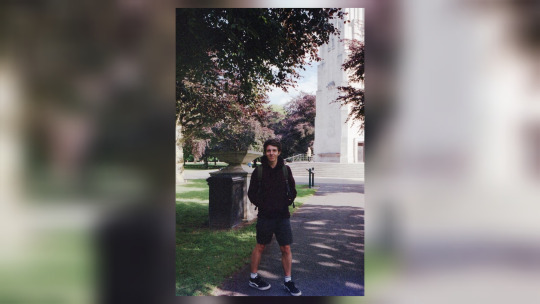
When I was younger, Garry Jones was one of the kids down my local park who was always out and about, always down for a skate, and always interested in more than just skateboarding. He contributed towards this very blog on many occasions donating footage, photos and even old cameras! His interest in photography proved to be something he had a great talent for, and now he is one of the UK's most prominent skate photographers: having snapped official shots of the Team GB skaters, and photographing some of the world's best skateboarders at Street League London and the European X-Games. I asked him some questions where he talks about photographing Tony Hawk, Jamie Foy, and of course, everyone's favourite northerner Joxa.
Those behind the camera sometimes don't get much recognition, so for anyone who doesn't know you - tell me a bit about yourself.
For sure, I'm Garry Jones - photographer from Coventry. Moved away for a few years to study my undergraduate but eventually came back to Coventry. Without sounding too much like a profile on a dating app: I'm 28 years old, and recently just completed my Masters Degree. I shoot photos of everything from beer brands to shoes but my main focus these days is working in the music industry, portraits and making album art. Saying that occasionally I get to shoot skateboarding also.
How did you first get into photography?
Not sure exactly when I decided I wanted to be a photographer, it was just always a notion I had from being a kid. Skateboarding influenced me pretty heavily: I had this Blueprint poster, can't remember the skater, but he was silhouetted doing a FS Krooked down a handrail and flashes going off behind him. I used to always stare at the poster figuring out how it was taken. My first steps into the photography world was in secondary school, using a darkroom where I learnt quite a lot to prepare me going forward.
What was your first "proper" camera?
My first DSLR was an Olympus e-410. I got it around the time I started college at the age of 16. That camera served me well: I shot my first events on it, and skate photos I was happy with. I think things got a bit more professional a couple of years later, when I jumped over to Nikon, and everything started to look a bit cleaner.
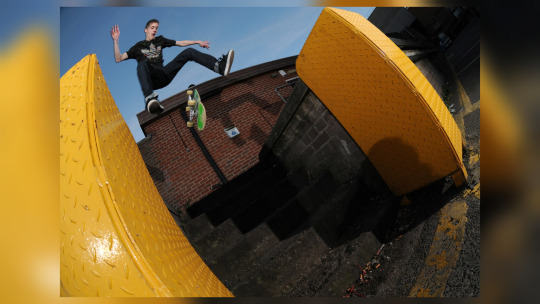
Tez Aldersley Varial Heelflip’s a yellow hazard in a Coventry back alley
Who were your influences growing up (skaters and photographers)?
Still to this day, there's not many "photographers" that really have influenced my work. If there is, it's more likely photographers that are my close friends that I work with, and they affect my work flow and style. It's skate culture, and the artists/documentarians within skateboarding, that have truly inspired me.
Ed Templeton is the first, and probably biggest influence: everything he has done with Toy Machine, to his photo books that come out on Um Yeah Art (which is Thomas Campbell's publishing company). Greg Hunt: as a film-maker, always really inspired me with his work with DC and Alien Workshop. I always thought it was really amazing and always used to try and find interviews of him speaking about his work.
French Fred and his documentation of my favourite brand Cliche really showed me what you can simply do with a black and white 35mm roll of film. Cliche really had such a cool visual aesthetic from their board graphics to the tour videos they put together, such a rad team also.
Mike Blabac too: his photography of Danny Way, and his first photo book were insane, and to this day those photos are incredible. What I liked about Blabac was the fact he could shoot a really good portrait in a studio also, and had this really nice high contrast imagery which really has influenced my work even more recently as I did a transition into more portraiture work.
Who were the first pro/sponsored skaters you ever shot?
Sponsored skater has to be Joxa, thinking back: me, you and Joxa used to head out a lot all over the place. Joxa was on Witchcraft back then, so it was always fun shooting with him, plus he's the coolest, most friendly dude. As for pro skaters: I was at NASS 2015 when the Birdhouse team came through on tour, and I had woken up a little bit worse for wear from the night before. I walked through the back entrance of the park and bumped into Jaws, shot a portrait of him with a fisheye and a flash, because I panicked and didn't have time to swap my lens. Later that day, I got to shoot Tony Hawk, which was insane, plus got to see Lizzie Armanto skate in person and she rips!
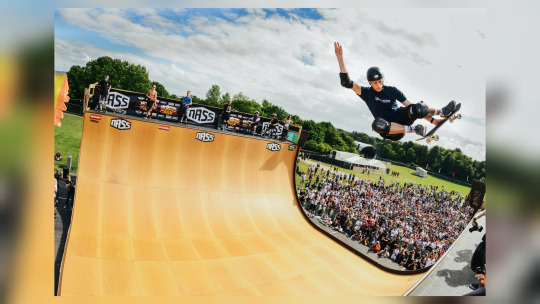
Tony Hawk with a FS Stalefish at Nass 2015
Who are your favourite photographers?
Hands down, my favourite photographer of all time is Ed Templeton. I love the way he documents the world around him. To go more outside of skating, Don McCullin is a British photojournalist who has work that needs to be seen either in a gallery or in the paper layout it was intended for. He documented the rise of the Berlin Wall, Vietnam and many other conflicts but his imagery is always so strong and tells the story like no other.
I was always a fan of Lewis Baltz's work too: He explored the notion of how humans use space, the 'urban', focusing on the shape and form. It was a very matter of fact style of shooting. I have a complete obsession with anything to do with the documentation of the Beastie Boys, so Spike Jonze has to be in there. His latest book is amazing, and the Girl collab boards are so sick. Also a lot of my favourite photographers are my friends I work with, as they are inspiring people: Mike Massaro shot a photo of artist Caribou that I just love.
What format is your favourite to shoot?
Ever since getting a medium format film camera, it's been my favourite. I really love shooting 6x6 medium format, so the frame is a square. Really tried to champion and shoot more film this year: in New York I shot a load of bands with my Bronica SQ 6x6 camera and fell in love with it all over again.
I saw you on BBC Sport taking pics in the background at the UK National Champs: Was it weird to see UK skateboarding being given such a huge spotlight?
I was really fortunate to come on board with Skateboard England early on, and shoot the announcement photos of the skaters for Team GB. At that point, or maybe even before that, Neil from Skateboard England had really kept me in the loop and tried to get me on board. Saying that, Neil has been a big supporter of me shooting skateboarding, and is the nicest dude, giving me loads of opportunities over the past 18 months.
To get back to your question, I wouldn't say it was weird, I would say it was about time. There's some really amazingly talented skaters in the UK, and the spotlight was being put on them deservingly. Hopefully we get to see the rest of this journey towards the Olympics soon. Add any of the guys and girls that were in that comp: if you go on their Instagrams, you can see how much they throw down, so everyone getting that moment of coverage is credit to them and their love of skating.
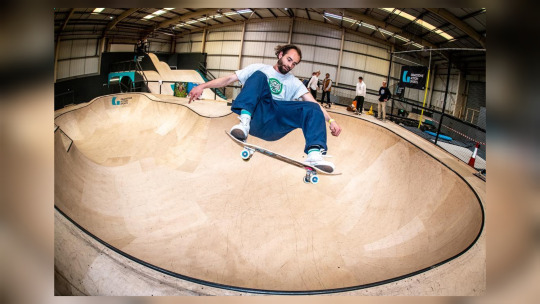
Alex Hallford at the UK National Championships last year
How did you end up taking shots for the European X-Games?
There's really no crazy story behind this: basically I emailed and asked. Shortly after, I got a reply saying they would love for me to come over. Just goes to show, putting yourself out there and having a conversation with someone goes a long way!
Which pros did you meet there?
I met Felipe Gustavo the first year I went along, with a few others, but to be fair to everyone, even in practice people were really focused that year. Second year I went, it was way more mellow for some reason. On the first day, I showed up after getting off of the flight and got to chill at the park and hang with Jamie Foy, who was the nicest dude. We spoke about his New Balance shoe, and his thoughts behind it while Gustavo Ribeiro was just tearing it up in the background. Kelly Hart was there judging last year's comp, which was cool as we had met before at Street League London a couple of times, so I got to catch up with Kelly again.
What was it like shooting someone as gnarly as Jamie Foy skating? Did he land everything practically first go?
At these big comps, the practice sessions are basically the guys putting their runs together: they are trying the same thing over and over again. Watching Jamie Foy just Krooked everything in sight super pinched was super gnarly, it was crazy to see that level of skating in person. On the other hand, there's Ishod Wair, who just flowed around the course adding bits on and improvised as he went: he's probably the best skateboarder in the world.

Leticia Bufoni with a BS Disaster at the European X Games in Norway
What was the difference in vibe between the European X-Games and the UK National Champs?
At the X-Games, you can really tell it's a big TV style presentation, with music and competitions and loads of other stuff going on, plus there's all the other sports there. At the UK National Champs, everyone knew each other, and if you didn't know anyone, by the end of the three days you did and it was rad. Churchill was on the mic, so what else do you need?
X-Games is that finished, high-end product that's been going for years, but I got to go to Simple Sessions' 20th event this year. Simple Sessions is this great comp run by people who do it for the love of skateboarding, and it comes across. Everyone has a really good time with loads of stories coming out of it. You see amazing skating at all of these events and I guess the difference in vibe is maybe down to what's on the line for these skaters who enter.
With so many high profile photography jobs on the books, do you get any time to skate?
Once a year, me and the Ghost Town Social Gang (Andy, Lyle, Ryan, Paul and Chris), go to a far away land like Paris or Barcelona and have a week or so of skating, hanging out and beers. On the run up to that I attempt to skate, but it doesn't normally happen if I'm truly honest. Think I'm more of a documentarian these days, and see skating as more social than ever, hanging out with some of my closest mates and having a push about.
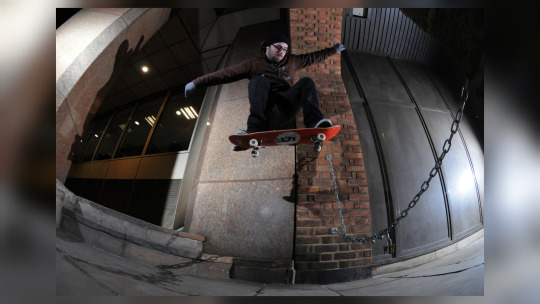
Cov’s own Andrew Scott popping over a unique gap opportunity
Did you get to skate the X-Games course?
Never got to skate it - saying that, I never have my board at those events, as I have to carry loads of camera gear and clothes for a few days. I wouldn't be able to skate it anyway: they have a schedule of who's allowed on the course to practice, and they break down the days so everyone gets time without it being hectic as the courses are only small. If you had all the men and women involved skating at once it would be chaos. I think you have to have the correct wristband to skate as there are stewards everywhere checking. I'm lucky I get pretty good access, just no athlete access!
What has been your favourite park/spot to photograph?
Favourite park to shoot was the first year Street League was in London, at the Copper Box Arena. Apparently, the course was awful to skate but it had the Union Jack done in concrete so up high the photos looked great. Also I have had some good times over the years shooting the vert at Epic/Creation: normally Jim The Skin is skating, so always get rad photos. The big Herbert 3 set in Coventry with the old cathedral in the background looks epic. I shot a photo of Tez Aldersley that I still love to this day of him kick flipping it.

Tez Aldersley floating a kickflip down at the Herbert spot in Coventry
Which skater (that you haven't photographed) would you love to get pics of?
Arto Saari would be sick! I love his skating. Spanky would be pretty high up: been really enjoying watching his footage recently. The skater that takes top of the list would have to be the fastest man in skateboarding: Dennis Busenitz. Just a photo of him pushing or bombing a hill would be a dream shoot!
What advice would you give to any aspiring photographers out there?
Just enjoy your photography. Put as much time as you can into it, and most importantly talk to people and make connections.
One last note on this: educate yourself! Take time to learn about photographers before you. Look at different areas, visit galleries, study photo books, listen to lectures - it all helps and gives you a better standing when moving into the professional world.
Anyone you would like to thank?
Firstly, I’d thank you Ade: all the lifts to parks years ago, and people I met through you, and the videos you made.
In skateboarding: big thanks to my friends over at Skateboard England, and always a big shout out to Jim The Skin and Ride. Everyone at X-Games & Simple Sessions: you rule.
Thanks to Andy Scott also, as he kept me in skating for years, he's the hype man. Vic Frankowski: always a supporter of my photography from Content (@hello_content). There are so many to thank, as I can’t do what I do without people giving me opportunities and their time. Love to everyone.
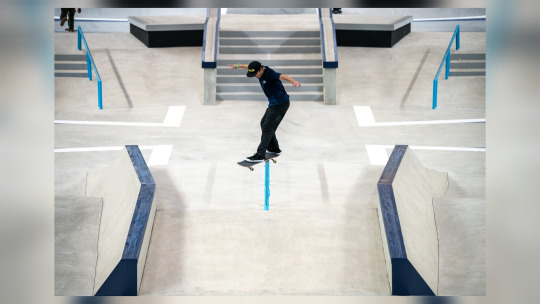
0 notes
Text
So, what I initially believed to be a genius original statement about Pet Sematary—that the movie should have stayed buried—turned out to be the title of, like, half a dozen movie reviews. And, now that I think about it, I probably stole it from Cinemasins’ review of the original 1989 movie…
My point is I was pretty disappointed by Pet Sematary.
Maybe it was my fault. Maybe I psyched myself out in the weeks leading up to the movie. Maybe I was disappointed because there were changes from the book? Or, maybe it really was just a bleh sort of adaptation to a Stephen King novel I really enjoyed.
Anyway, here are some things that bothered me, and a few things I liked.
Cue the original Ramones’ tune.
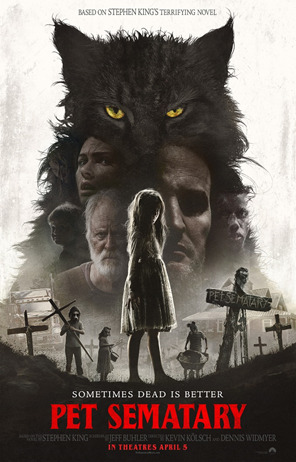
Source: https://www.joblo.com/movie-posters/2019/pet-sematary/image-35124
Naturally adaptations can be tricky. There’s always going to be guys and gals like me complaining that they changed too much from the book, or that they didn’t change enough about it. And there are times when things need to be cut because, realistically, only so much of a text can fit into a 2-hour run time while keeping the interest of its fickle audience.
But I’m not against the idea of changes in adaptations. It—the 2017 version-- for example, was a great adaptation of a Stephen King work. It remained mostly faithful to the first half of the book while making some changes. They left out the giant space turtle that spewed out the universe after a sore tummy, the hotboxing the kids do in their fort that shows them the monster’s origin story, and—thankfully—the train the boys run on Beverley in the tunnels.
I didn’t care that left out that stuff. It really doesn’t change the premise of the story or the personality of the characters. The fact that they changed the time period from the 50s to the 80s, for example, barely alters anything aside from at whom to direct the nostalgia. Basically, any town in a Stephen King work can be translated into whatever decade you want. Middle America, from what I hear, doesn’t change all that much.
What bothers me is when changes are made just for the sake of change, because they think they’ll wow the audience, because their movie needs jump scares like all the other horror movies out there, or because they want to be like M. Knight, and throw in some Shyamalan-style twists.
Take those creepy kids from the trailer:
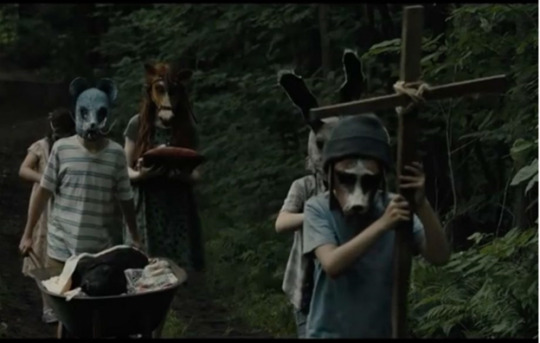
Source: https://www.nme.com/news/watch-creepy-new-trailer-stephen-kings-pet-sematary-released-2388664
Sure, aesthetically, that’s some spooky imagery. It’s not in the books, but that’s fine. They looked creepy, with their masks, walking in a funeral procession, banging that drum. Great stuff for a trailer. But they don’t do anything with it, save for Ellie wearing a similar mask in the climax. There’s no point of it being in the movie at all. If the kids weren’t in it, we’d still have the Pet Sematary itself. We’d know that kids buried their pets there. Nothing would change other than the number of people to add to the end credits.
Someone could argue, oh, maybe it implies that these creepy kids were also buried? There is that highway they keep open for some reason. Maybe they were also run over by trucks? Maybe they came back wrong?
And I would totally love that as a concept. It would definitely help with this movie’s ending. A town that eventually gets over-run with zombies, and the last few humans must hunt them down?

Source: https://waxworkrecords.com/collections/vinyl/products/salems-lot
Oh wait…that’s the plot to ‘Salem’s Lot…
Unfortunately, for maybe the first time ever in a Stephen King movie—save for the Shining and Gerald’s Game, which were more character pieces anyway—we never really meet anyone else in the town, save for Jud. So, I can only assume that the kids are unaware of the real evil burial ground behind the Pet Sematary, and just like to dress up when burying their dead pets.
Plus, we see Church and Ellie are constantly dirty after they’re resurrected. These kids are clean, especially for kids. So, we can rule out them being anything other than the subjects of the next Killer Kids.
Sure, the kids are creepy. But it does nothing for the movie in the long run. The isolation of the Creeds among the woods can provide the chills and thrills we seek without relying on creepy children we never see again…
They also change which Creed child gets hit by the truck. I’ll be honest, I didn’t see the trailer. I wanted to go in fresh. So, I had no idea Ellie was featured as the main zombie in this…
In the book, Gage dies. This was, I hear, inspired by a close call Stephen King had with his own son. The premise of the book came from the what-if that plagued him. And it’s because Gage is so young, a little boy no older than 2 or 3, with his whole life ahead of him, that makes his demise so tragic.
Granted, Ellie is only nine, so it’s still incredibly tragic. So, I’m not upset by the decision to change it. I mean, I saw the original movie from 1989. The special effects they use for evil Gage were…not very good. And even in the book, some of the things that come out of the dead boy’s mouth are a tad silly—even for King, who, again, wrote a scene in which eleven-year-old boys take turns having sex with their one girl friend to escape the monster’s tunnel, despite having defeated, at least for the time being, the monster. I completely understand the decision to avoid something like this from happening again:
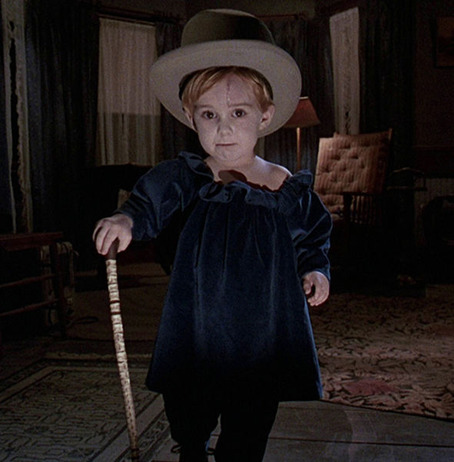
Source: https://www.express.co.uk/celebrity-news/726081/Stephen-King-Pet-Sematary-kid-Gage-Creed-looks-like-now-Miko-Hughes
But I think that’s only half the reason they changed it to Ellie. I really think they just wanted to throw a twist at those of us who read the book. And that’s something I don’t like. Twists for the sake of twists aren’t cool. Trust me, I wasn’t bored when little Gage Creed started running over to the highway with glee. I knew what was coming and was still uncomfortable. The fact Ellie got hit instead was more of an “oh…I guess they’re going that way? Makes sense…”
But all of that I’d give a pass, if not for the jump scares—and this movie probably has more fake out jump scares than people in the movie—I won’t count Rachel’s parents, since they have no lines, or Zelda, who is more of a tool, or the cat because it is a cat.
Jump scares aren’t scary to me. If I jolt in my seat, it’s because my ears are being assaulted by sudden noise, and my body is reacting to it. The pounding in my chest is not because I expect Ellie to be hiding under the bed, or behind the door. It’s because I’m waiting for that dumb sound. It’s not going to keep me up at night, thinking about the creepy things I saw in the movie. It just makes me regret seeing it at all. Its cheap, and so many horror movies use them—even the good ones.
Rachel’s sister’s affliction with spinal meningitis, and her death, was, for me, the best part of the book and both the 1989 movie, and this adaptation. I grew up with a sibling who dealt with ailments all her life, and she passed away because of them, so Zelda’s demise is the only part of the movie and a major part of the book that made me squirm in my seat. I don’t know about anyone else who watched the movie, but someone who is ill is plenty scary, and for many reasons: the visual of it, seeing the person in so much pain and being unable to help, but also the guilt you feel because you don’t have to go through it. And, worst of all, that part of you is glad when their pain finally stops.
It’s a powerful image, and the movie got points from me for it.
But there are some issues, still. They change the way Zelda dies. In the book, she chokes to death, and Rachel hears her suffering, but doesn’t do anything because she doesn’t like interacting with her sister anymore. In the movie, they have Rachel send the food up to Zelda through a dumb-waiter, and Zelda falls attempting to grab the food for herself.
It seems like a silly thing to gripe about, given the conclusion is the same: Zelda dies, and Rachel is scarred by it. But they changed it, I think, because visually it looked scarier than the book and they couldn’t figure out how to add a jump scare to a motionless teenager. Again, I don’t know if anyone else has experienced it, but watching someone go that way—i.e., slow and painfully-- is terrifying. And it would have served the movie better because stuff like that happens.
Also, there’s the fact that Rachel herself says Zelda was bed-ridden and couldn’t move around much. So, I doubt that Zelda climbed out of bed herself and fell down a dumb-waiter.
Now, is the movie bad because not everyone in the audience had the misfortune of watching a loved one die? No. People are scared by different things, as we see in all of King’s works—clowns, vampires, werewolves, creepy shop owners, getting left in handcuffs in your cottage miles away from civilization because your husband took too many blue pills and got a heart attack when you kicked him, because he wouldn’t take no for an answer, and then a dog eats him, and there’s something about a killer on the lose…The usual stuff.
But I do think that what we got was not nearly as creepy as the book.
They keep Victor Pascow in the movie, which could have been left out. I wasn’t super into the ghost concept in the book to begin with. It’s not necessary. They establish early on that the burial ground calls to its victims. Jud could have been the one to try to warn Louis and Rachel to stay away. And the barriers still would have been there to keep Rachel from getting to Louis on time. There, the movie stays pretty much the same with some minor tweaks.
The movie clearly gets tired of Victor, however, because he stops showing up after he gets Gage’s attention and Rachel decides to go see Louis. In the book, Victor is a semi-regular presence once they come across the Pet Sematary. After Gage dies, Victor warns Louis not to give into the pull of the burial grounds. Then, when that doesn’t work, Pascow tries contacting Ellie—who did not get hit by a truck in the novel—who tells Rachel, who recognizes the name from earlier, and then goes—on her own—to see Louis. It was actually pretty silly for her to bring her baby along with her if she thought there was something to be worried about…But I guess we wouldn’t have this movie’s ending if she did the reasonable thing…
On the way home, a series of events take place that hinder Rachel from arriving on time, implying the burial ground’s magic works beyond the town in which its situated.
Now, this plays out pretty much the same way in the movie, but differently. We know that the burial grounds have a pull to them, but it’s done…more quickly. As if they realized, oh, we’ve reached the climax of the film and haven’t used our creepy murder kid to murder people yet. Better do that.
I also was not a fan of the way Ellie physically changes to look like Zelda to taunt Rachel, nor the way Rachel imagines herself in a bed with her spine twisting. To be honest, I don’t recall whether it was like this in the book. If it was, I would have preferred they didn’t add that to the movie at all. The movie is creepy with its main premise.
Also--and again, maybe this is an issue that was also present in the book—why would Rachel go back to her parent’s house, when she spent the entire movie talking about how she could hear Zelda in the walls? She’s there a whole day and then she goes through that illusion. I know she didn’t want to be in the new house after Ellie died. But couldn’t they have written that Rachel went to stay with her parents in a different, non-Zelda haunted house?
Ah, but then we wouldn’t get the creepy scene with Rachel’s spine twisting, with jump scares…Bleh.
OH! And then there’s this one line in the movie that bugged the crap out of me.
OK, so, in the book, Ellie is asking her parents about death—like she does in the movie—and she asks why God couldn’t just take his own cat.
Well, this line is altered and given to Louis in the movie. Rachel asks why Louis brought Ellie back, and he says something along the lines of God can kill his own kid.
Louis Creed may not be very well versed in Christianity. He professes to not believe in an afterlife. No worries. I don’t expect everyone to know everything about the religion—I certainly am not an expert. But how could he not know that’s exactly the story of Jesus, one of the most well-known religious figures on the planet? I’m talking just the basic stuff someone who went to a high school or college or watched a movie or read a book would know. God sent Jesus down to earth to die for the sins of humanity… It’s a small gripe, I guess. Maybe someone in real life would say that—probably in response to the old funeral favourite: it’s God’s plan. People say all sorts of things when grieving. Maybe the extent of Louis’ knowledge about religion is limited to Judaism, where Jesus isn’t a major figure.
But it just sounded like a dumb line in a movie I already wanted to be over.
Pet Sematary is a very quiet sort of horror novel. I mean, Louis burns down his house, and shoots both his dead son and the evil cat. But aside from that, the terror comes from the book’s main theme: coping with death, specifically young people. It’s about the unfairness of the people or things we love leaving us so soon. Louis’ temptation to bury Gage/Ellie is heart wrenching, because who among us wouldn’t have considered it? The burial ground doesn’t need a magic pull. Knowing of its existence would be enough. Because it’s human for that temptation to be there. And it’s made even more difficult to read about/watch when Louis does it all again after burying his wife—right after shooting his little boy.
But we don’t get any of that in this movie. Louis gets killed by his resurrected wife and is also buried. The movie ends with the dead family—Church included—closing in on young Gage Creed, who was put in the family car for safety by Louis.
Cue a cover of the Ramones song.
Maybe if I never read the book, this would have been a cooler ending. I really didn’t want to keep comparing the movie to the novel. I wanted to give it a fair chance to stand on its own. But it’s difficult not to compare. I honestly think the book is better—by a long shot.
The movie had good moments, though. The burial grounds themselves look amazing—far better than how I imagined it while reading the book. Although, I swear the symbol on the trees used to ward off people looks exactly like the symbol of the Kokiri stone from Legend of Zelda: Ocarina of Time. I couldn’t find a still from the movie on google, but I can’t be the only one to see it, right?

Source: https://zelda.fandom.com/wiki/Deku_Shield
Now that I think about it…the Kokiri are children…and they become Koroks, who wear weird masks…Could Legend of Zelda and Pet Sematary share a universe?!
We don’t see the Wendigo much in the movie, but we didn’t get a good look at it in the novel either. Less may have been more in this case. And the cast is great. The Creed family is sweet together. And John Lithgow is always fantastic.
But the movie just didn’t do it for me.
At the very least, it got me to want to read the book again.
#pet semetary 2019#stephen king#wendigo#the ramones#movie reviews#sometimesdeadisbetter#shouldhavestayedburied#winstonchurchill#zelda#kokiri#victor pascow#gage creed#derry maine
1 note
·
View note